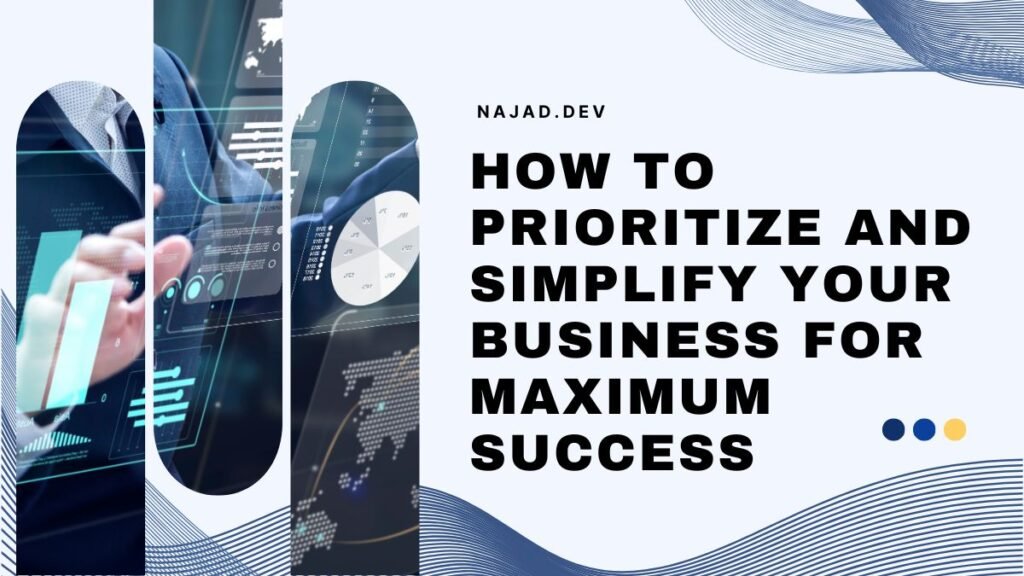Running a business is tough, no doubt. But often, we make it way harder than it needs to be. One critical mistake many entrepreneurs make is failing to prioritize tasks effectively. This not only wastes time but also keeps your business from reaching its full potential. So, let’s talk about how to stop spinning your wheels and start building momentum. 🚀
In this post, we’ll explore why prioritization is the key to simplifying your business and how to master it with a step-by-step method. Ready? Let’s dive in!
The Problem: Building Without a Blueprint
Imagine you’re building your dream house. You hire top-notch contractors, eager to get the job done quickly and perfectly. But when you visit the site, you find they’ve started framing the house without laying the foundation. 😳
When you ask what’s going on, they admit they didn’t have a blueprint. Without clear priorities, they didn’t know what to tackle first.
Does this sound familiar? If you’re running your business without a clear plan, you’re essentially doing the same thing—making it ten times harder than it needs to be. Even if you’re amazing at what you do, lack of prioritization can keep your business stuck or growing slower than it should.
The Solution: Mastering Prioritization
Prioritization is like turning on your TV. You can’t skip to choosing a Netflix show without first pressing the power button. Similarly, in business, you can’t tackle the big picture without first addressing foundational tasks. Here’s how to do it:
1. Understand Systems Thinking
Every action in your business is part of a system. A system has three key components:
- Inputs: What you need to do.
- Processes: How things get done.
- Outputs: The results you’re aiming for.
For example, if your goal is to acquire more clients, the output might be increased sales. The process could involve a sales funnel, and the input might be creating content to drive traffic. Each system influences others, so understanding these connections is crucial.
2. Start with the End in Mind
Begin by identifying your desired output—your goal. Then work backward to figure out what inputs and processes are required. Think of it as reverse engineering your success. 🛠️
3. Map Your Systems Ecosystem
Use tools like Milanote or a whiteboard to map out all the systems in your business. For each system:
- Define the output (goal).
- Outline the process.
- Identify the input.
This visual overview helps you see how tasks are interconnected and which ones have the highest impact.
How to Prioritize Tasks
Now that you have a clear understanding of your systems, follow these steps to prioritize tasks:
Step 1: Set Clear Goals
Ask yourself, “What do I want to achieve?” Without a clear goal, prioritization is impossible. Define your top objectives and write them down.
Step 2: Focus on High-Leverage Inputs
Identify the tasks that will create the most significant impact. These are your high-leverage inputs—the ones that set other processes in motion. For instance, driving traffic to a sales page might be more impactful than tweaking the sales page itself if no one’s visiting it yet.
Step 3: Tackle Bottlenecks First
Imagine your business systems as a pipeline. If water (cash, clients, traffic) isn’t flowing freely, find the blockages. Start with the bottleneck closest to the beginning of the system, as fixing that will have the most significant ripple effect.
Step 4: Use Data to Guide Decisions
Track metrics at each step of your systems. For example:
- How many leads visit your website?
- How many convert into customers?
- Where do most drop-offs occur?
Focus on areas where performance is below benchmarks.
Simplify Your Daily Priorities
Once you’ve mapped your systems and identified bottlenecks, simplify your daily workflow:
- List 1-3 tasks each day that directly push you toward your goals.
- Eliminate or delegate low-priority tasks.
- Review and adjust your priorities regularly.
Build Momentum
When you consistently prioritize high-leverage tasks, you’ll:
- Get more done in less time.
- Build momentum in your business. 🌟
- Achieve goals faster than ever before.
So, stop making business harder than it needs to be. Map your systems, set clear goals, and tackle high-impact tasks first. Your dream business is closer than you think—you just need the blueprint to get there.
Ready to transform your workflow? Let’s go! 💼✨

